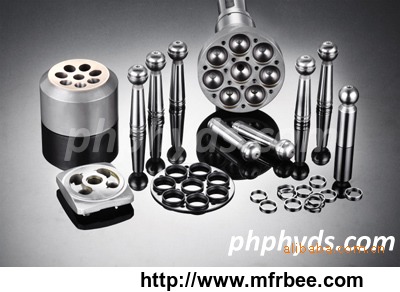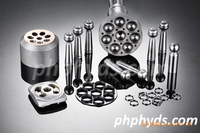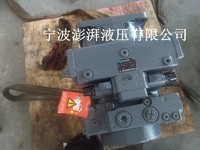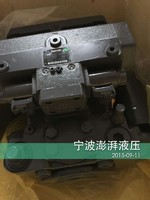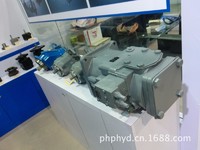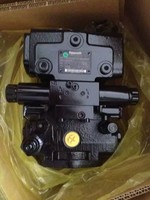pto driven hydraulic pump hydraulic hand pumps
Specifications
hydraulic pump manufacturers_hydraulic pump parts_hydraulic pumps and motors suppliers in china
China hydraulic pump manufacturers, hydraulic pumps and motors, hydraulic pump parts, piston pump parts, hydraulic pump, hydraulic spare parts, hydraulic piston pump, hydraulic vane pump, hydraulic gear pump, Hydraulic Motor,Pilot Pump, Charge
Pump Rexroth,Caterpillar,Vickers,Denison,Sauer,Kawasaki,Commercial,Linde,Parker,Liebherr,Komatsu,Eaton,Daikin,Kubota,Johndeer,Hitachi.
T6C,T6D,T6E,45VQ,35VQ,25VQ,20VQ,V10,V20,Hydraulic Motor.
Our website: www.pepfluid.com
Relative movement between the two can.
Spool
Piston and secondary piston moves from the left end of the spring with the spool valve body constitutes the right level balance.
By moving the swash plate piston sleeve
Control, with the movement of the swash plate piston is moved, its distance and direction of movement of the piston with the swash plate consistent.
?② two pistons:
In the electronic control state,
Pilot secondary oil flow control two separate piston,
Negative flow does not participate directly
control,
But collected by the negative pressure sensor pressure parameter,
To the computer,
As calculated by the computer controlled electric current proportional valve
A parameter to control the pilot secondary oil stream;
In the pilot state,
Pilot secondary oil stream is truncated changed electronically controlled hydraulic valves,
Does not participate
The secondary piston control,
By the negative flow on the secondary piston alone direct control.
Secondary working direction of the piston is pushing the slide
The leftward movement of the valve spool, constitute the balance comes from the spring return.
?③ a piston:
Pump oil flow from the former,
After pump oil flow and the primary pilot oil flow
(In the pilot states only)
Control,
Direction of its work to promote the leftward movement of the spool valve body by its own spring return form balance.
3.
The actuator is a variable piston:
Variable piston fixed cross-sectional area of ??the piston sleeve and a plunger ends sample sizes constitute,
The plunger and the swash plate and
Slide valve sleeve connection, when the two end faces pressed to generate pressure, the plunger drive the other two sports together.
Let's analyze the hydraulic system pressure and flow control in concrete changes in the relationship between the high-pressure pump in the middle.
?guiding ideology:
1.
Pressure depends on the load
.2..
Pressure and flow high pressure pump output is inversely proportional.
?
1, according to whether the flow can be adjusted can be divided into: variable displacement pump and metering pump. Output flow can be adjusted as needed is called variable
displacement pump, the flow rate can not be adjusted is called a metering pump.
2, according to the hydraulic system commonly used pump structure is divided into: gear pumps, vane pumps and piston pumps three kinds.
Gear pumps: smaller, simpler structure, strict cleanliness requirements for oil, the price is cheaper; but the shaft by the unbalanced force, badly worn, a large leak.
Vane pump: two double-acting and single acting vane pump vane pump. The pump flow evenly, smooth operation, low noise, operating pressure and volumetric efficiency than gear
pumps, complex structure than the gear pump.
?????
Piston: high volumetric efficiency, leakage small, can work under pressure, mostly for high power hydraulic system; but the complex structure, material and machining high
precision, expensive, high oil cleanliness requirements.
Pump principle
Usually when a gear pump and vane pump can not meet the requirements for piston pumps. There are other forms of pump, such as a screw, etc., but not as good as the
above-described three kinds of universal application
?????It provides pressurized hydraulic fluid to a hydraulic element hydraulic transmission, a pump. Its function is to power machine (such as electric motors and internal
combustion engines, etc.) of mechanical energy into fluid pressure energy. Single-piston pump works cam is rotated by the motor, when the upward movement of the cam push the plunger, piston and
cylinder form sealed volume decreases, fluid extruded from the sealed volume, is discharged through the check valve to go where they are needed. When the cam is rotated to drop parts of the
curve, the spring forces the piston down, a certain degree of vacuum, the oil tank into the sealed volume at atmospheric pressure. Cam lift the plunger constantly, periodically sealed volume
decrease and increase, the pump will continue to suction and discharge of oil.
?
???High-pressure pump test-bed system may be implemented now conventional fuel injection system function can not be completed, its strengths are:
1, high-pressure fuel injection pump test pressure Taichung flexible adjustable for different conditions can determine the best pressure required eruption, and then optimize
the diesel engine induction function.
2, can alone at once flexible injection timing control, high pressure eruption cooperation (120MPa ~ 200MPa), NOx and particulates can be controlled together (PM) in a smaller
value, to the satisfaction emission requirements.
3, the flexible control injection rate changes, complete ideal fuel injection law, simply complete the pre-eruption and repeated eruptions, can decrease diesel NOx, while
ensuring excellent power and economy.
4, the solenoid valve control fuel injection, high precision of its control, the high pressure does not appear bubbles and the appearance of residual pressure to zero, and
therefore within the operating range of diesel engines, fuel injection cycle a small amount of change, the cylinder oil is not uniformity can be improved, then reduce the vibration and decrease
emissions of diesel engines.
How to control the flow of piston:
?(L) improvement of the plunger system planning. After repeatedly proved that the final choice of the leading full-load sensing priority valve and plunger steering mode, in
accordance with the new system can shift demand to assign traffic priority, regardless of load size, steering wheel speed bump can ensure adequate supply, and the rest Some can all work
equipment supply circuit use, because the steering circuit and eliminate excessive oil caused by power loss, the progress of the system p
- Country: China (Mainland)
- Business Type: Manufacturer,Trading Company
- Founded Year: 2009
- Address: 中国 浙江 宁波市鄞州区 诚信东路388号(福庆南路欧琳集团东面)
- Contact: hansen Huang
